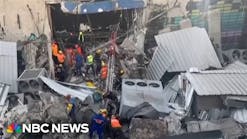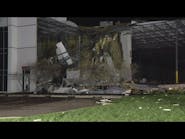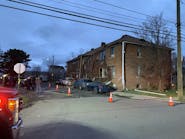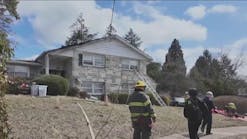Trics Of The Trade: The Rescue/Pumper and the FDNY Squad Concept - Part 3
Building collapses are no stranger to New York City fire units, but the squad companies play a vital role in the rescue of viable victims.
As with any technical incident, our response tactics vary tremendously from our response to a working fire. The key words here are "slow down!"
Recently in New York City there was a crane collapse. Not one, but two and both within the span of about two months. Amazing!
At the first crane collapse, this massive piece of machinery literally fell out of the sky, landing on a five-story Brownstone type building, causing a pancake style collapse. This crane turned a five story building in to a pile of debris that was a little more than two stories tall, not including the sections of the crane that came to rest on top of the debris pile.
In addition, the toppling crane caused the partial collapse of exposure two (left side) and damaged another building on its way down. Eventually, seven people were to die in this collapse including some of the workers that "rode" the crane as it fell 19 stories, bouncing off of other buildings until it came to rest on top of this Brownstone. The amazing part of this story is that it was 2 p.m. on a sunny Saturday in Manhattan and that section of the street was empty when this event occurred, sparing an untold number of lives.
A structural collapse is an incident where a building or portion thereof including walls, floors or ceilings have collapsed. A structural collapse is one of the most dangerous and difficult operations a firefighter will encounter.
The first arriving units may find clouds of dust or smoke surrounding the area with injured and disoriented people requiring assistance, not to mention there may also be people still trapped inside the collapsed building or on top of the debris pile. As an officer you must remember to control your people and the operation. Our safety is the number one concern.
Relating to the squad company concept, we will discuss the basic operations of a squad company arriving at a collapsed building and some general collapse operations and considerations that everyone must consider when operating at a collapse scenario. The operations and procedures stated below are not all encompassing and by no means shall it be construed that reading this article makes you a collapse technician. These are just tidbits of information from the operational procedures we use in the FDNY.
Crew Assignments
The squad companies operate using the team concept. In New York City we have a minimum manning clause that requires all rescue and squad companies to start the tour with five firefighters and an officer. The team concept allows us to break into two teams of three or three teams of two, the latter of which is used most often, except, perhaps, in a collapse situation.
Upon arrival the apparatus will be placed outside of the collapse zone but as close as possible to create easy access to the needed specialized tools and equipment. The officer will go directly to the command post to check-in and gather as much information as possible. Some of the vital information includes: What could have possibly caused the collapse? Are the utilities under our control? How many victims might there be and their possible location. Are any other buildings affected and if so are they too in danger of falling? Has the collapse rescue plan been initiated?
The other members of the unit will await their orders while gathering the tools according to their assignment. The chauffeur will take the battery operated reciprocating saw and spare batteries, the can man will take the collapse bag and will be the main entrant for search. The roof man will be the back up for the search and will take locking struts for initial support. The irons man will start to set up a cutting station with the hook man. The cutting station is set up to cut lumber as needed for shoring as we initiate void searches.
These positions are a starting point, dependent upon the severity of the collapse and how extensive an area it covers. We will have many units responding in to a confirmed collapse and their training will dictate where they will work and what tasks they are assigned to.
At an extensive collapse it would not be uncommon to have two or three rescue and squad companies working to accomplish the initial surface rescues. If a victim is found and pinned, work will commence immediately to remove the debris that is impeding the removal. Dependant upon the severity of the injuries and the complexity of the extrication, FDNY has rescue medics assigned to the EMS division that have been trained by the rescue and squad personnel to work in this type of an environment. These paramedics will be permitted access to the patient to evaluate or establish an intravenous.
Victim Survival
Although victims of collapse have survived for 14 days and in a few cases longer, the potential for victim survival decreases as time moves on. The following are the potential survival ratios for victims buried in a collapse.
Time of Extrication vs. Survival Rate
30 minutes.................99.3%
1 day........................81%
2 days......................36.7%
3 days......................33.7%
4 days......................19%
5 days......................7.4%
As a specialized unit, the squads and rescues are automatically assigned to collapse incidents. All squad and rescue companies are trained in collapse rescue operations and carry equipment such as void search cameras, shoring material, and struts to initiate operations at such an incident. The rescue apparatus, by virtue of it size, carries more equipment than a squad, but the training levels of both companies are the same.
Additional Resources for New York City
In addition to the squads and rescues being assigned to a confirmed collapse, we have several other special units to assist during these incidents. The collapse rescue units carry additional equipment, tools and shoring to sustain the operation. The tactical support unit supplies lights, electric and additional hydraulic capabilities. The Special Operations Command support ladder companies provide additional manpower. A compressor truck is used to supply air power, and a special operations support vvehicle carries the disposable items such as blades, batteries, five gallon buckets, etc. Collapse PODS can be requested by a command chief for more lumber and a Con Edison (our electric company) vacuum truck may be requested as needed.
As you can see we have a tremendous amount of resources available to us in relatively short order. Our collapse rescue operation plan is designed to provide the greatest chance of survival to the greatest number of victims, while using the most efficient deployment of manpower. It is comprised of five stages and it is recommended that when used it is carried out in this preferential order:
- Reconnaissance: This first stage constitutes a portion of the incident commander's size-up. This is where the reconnaissance /intelligence gathering process occurs. Before searches can commence we must identify: What happened? Where? Who's missing? Where were they last seen? Is there any possibility they are alive? What is the situation regarding fire, secondary collapse, explosions, or other dangers. Is this the result of a terrorist attack? Our actions will be guided by the risk verses reward consequence of our actions.
- Accounting for and removing surface victims: Victims will be found in various degrees of entanglement. We begin by removing the least entangled persons first and other persons that require the least assistance. Get these peoples names and location where they were found. They may also provide valuable information as to the locations of others that may be trapped
- Searching Voids: Voids are often created that could shelter victims. There are four common types of voids. They are "V-shaped", "pancake", "lean-to" and "individual" voids. Locating victims in a collapse can be accomplished using a number of methods.
- Selected Debris Removal: This stage begins when all voids have been searched and people are still unaccounted for. This method is used to reach specific areas where victims are believed to be located.
- General Debris Removal: After all other methods have been exhausted and people are still missing and their location is unknown, rubble is removed and each area is systematically stripped. This stage is initiated when it is certain that there are no other survivors. Each load of debris is laid out on the ground and sifted through by the members before it is removed from the collapse site. A debris removal log will be maintained and every inch of the structure, right down to the foundation will be examined to assure that we did not overlook a victim that may not have been reported.
This is just a brief synopsis of how the FDNY special operations companies work at a structural collapse. We will remain at the collapse site until the incident commander is reasonably certain that all victims have been removed and then maintain a watch line as long as necessary for investigative purposes.
Remember the number one priority is the safety of the members and knowledge of the causes and warning signs of a collapse can help to prevent members from getting caught in a collapse or a secondary collapse.
Train and study, it will help you to understand how and why buildings collapse. We are the eyes and ears for the incident commander. Regular training keeps you sharp. The actions you train on become second nature. Use them, they are just some more...Tric's of the Trade.
Related:





